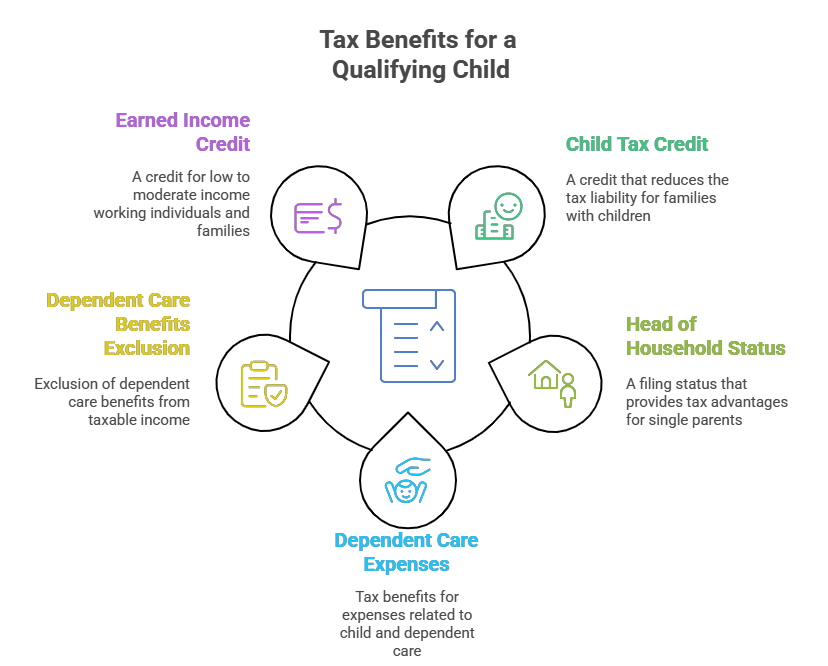Contributed by: Henry, FreeTaxUSA Agent, Tax Pro

In certain situations, a child can meet the tests to be a qualifying child of more than one person. This means multiple individuals could potentially claim the child as a dependent or designate them as a qualifying person for the head of household filing status. However, a child can only be claimed as a dependent on one tax return, and they can’t qualify more than one taxpayer for the head of household filing status for the year. The IRS has rules in place to help determine who can claim the various tax benefits for a qualifying child. Typically, the credits follow the child on the tax return.

Situations of divorce or separation
In situations of divorce or separation, the parents may be eligible to divide up the tax benefits for claiming a child between two people. This is done based on who is considered the custodial parent and the noncustodial parent for tax purposes, which may be different from what’s suggested in a court ordered plan. Divorce is a civil matter; tax returns are a federal matter.
Generally, the custodial parent is the one with whom the child lived for the greater number of nights during the year. If the child lived with each parent for an equal number of nights, the custodial parent is the parent with the higher AGI.
The custodial parent is eligible to claim the head of household filing status, the earned income credit, and childcare expenses when the child is claimed as a qualifying person. The noncustodial parent may only claim the child tax credit, credit for other dependents, or additional child tax credit for the child.
Often, a custody agreement instructs parents to trade off who gets to claim a child as a dependent each year:
- In years when the custodial parent is claiming the child as a dependent, the custodial parent may claim the child tax credit/credit for other dependents/additional child tax credit, head of household filing status, the earned income credit, and childcare expenses. The noncustodial doesn’t list the child on their tax return.
- In years when the noncustodial parent is claiming the child as a dependent, the custodial parent must sign Form 8332, Release/Revocation of Release of Claim to Exemption for Child by Custodial Parent, allowing the noncustodial parent to claim the child tax credit/credit for other dependents/additional child tax credit. The noncustodial parent will attach Form 8332 to their tax return. They’ll also indicate the child didn't live with them for more than half of the year to prevent the other tax benefits from being claimed in error. The custodial parent would then indicate the child did live with them for more than half of the year and could claim the head of household filing status, the earned income credit, and childcare expenses.
All other situations
In all other situations, where more than one person qualifies to claim the child, the following rules from IRS Publication 501 apply:
“Sometimes, a child meets the relationship, age, residency, support, and joint return tests to be a qualifying child of more than one person. Although the child is a qualifying child of each of these persons, generally only one person can actually treat the child as a qualifying child to take all of the following tax benefits (provided the person is eligible for each benefit).
- The child tax credit, credit for other dependents, or additional child tax credit.
- Head of household filing status.
- The credit for child and dependent care expenses.
- The exclusion from income for dependent care benefits.
- The earned income credit.
The other person can’t take any of these benefits based on this qualifying child. In other words, you and the other person can’t agree to divide these tax benefits between you.”
If more than one person can claim a child as a qualifying child, use the tiebreaker rules listed in the 1040 instructions to determine which person should claim the child. Most common scenarios are addressed there.
Preparing your tax return
FreeTaxUSA software makes it easy for you to enter your dependent or qualifying person. Simply go to Personal > Dependents and add a dependent. If you aren't sure if someone qualifies, add them and we'll help you figure it out. We’ll apply the IRS guidelines based on the information you provide. As long as you answer the questions about your dependent correctly for your situation, you can rely on the accuracy of the software regarding your ability to claim a dependent or use a certain filing status.
Examples
Here are some scenarios to illustrate what to expect in various situations.
Example #1: You lived with your boyfriend, Sawyer, all year. You and Sawyer have a 2-year-old child together. Your AGI was $42,000, and Sawyer’s AGI was $64,000. Your child is a qualifying child of both you and Sawyer, but the IRS tiebreaker rules allow the parent with the higher AGI to claim the tax benefits of a qualifying child. The IRS doesn’t allow you to divide up the tax benefits of having a qualifying child between you. Sawyer has the higher AGI, so he claims all the tax benefits of having a qualifying child, including using the child as a qualifying person for the head of household filing status. You remove the child from your tax return completely.
Example #2: The facts are the same as in Example #2, except Sawyer agrees to let you claim the child. This means you can claim all of the tax benefits of having a qualifying child, including using the child as a qualifying person for the head of household filing status. Sawyer removes the child from his tax return completely.
Example #3: Your son, Jack, and his 5-year-old daughter lived with you all year. Jack’s AGI was $22,000, and your AGI was $76,000. Jack's daughter is a qualifying child of both you and Jack, but the IRS tiebreaker rules allow the parent to claim the tax benefits of a qualifying child. The IRS doesn’t allow you to divide up the tax benefits of having a qualifying child between you. Jack plans to claim his daughter as a dependent, so she isn’t your dependent or your qualifying person for head of household purposes.
Example #4: The facts are the same as in Example #3, except Jack agrees to let you claim his daughter as a dependent. This is allowed because your AGI is higher than Jack's. Jack removes his daughter from his own tax return, and you claim all the tax benefits of having a qualifying child, including using your granddaughter as a qualifying person for the head of household filing status.
Example #5: You and Brett are divorced. Your daughter, Ruby, lived with you most of the time and stayed with Brett on weekends. This makes you the custodial parent and Brett the noncustodial parent. The divorce decree allows Brett to claim Ruby as a dependent on his tax return. As the custodial parent, you are the one who can claim Ruby as a qualifying child for the head of household filing status, the earned income credit and childcare expenses. In this situation, Brett can claim Ruby as a dependent and get the child tax credit/credit for other dependents/additional child tax credit, but he cannot use Ruby to claim the other tax benefits of having a qualifying child.
Example #6: The facts are the same as in Example #5, except that Ruby lived with Brett more than half the year, so he is the custodial parent. Brett claims all the tax benefits of having a qualifying child, including using Ruby as a qualifying person for the head of household filing status. You remove Ruby from your tax return completely.